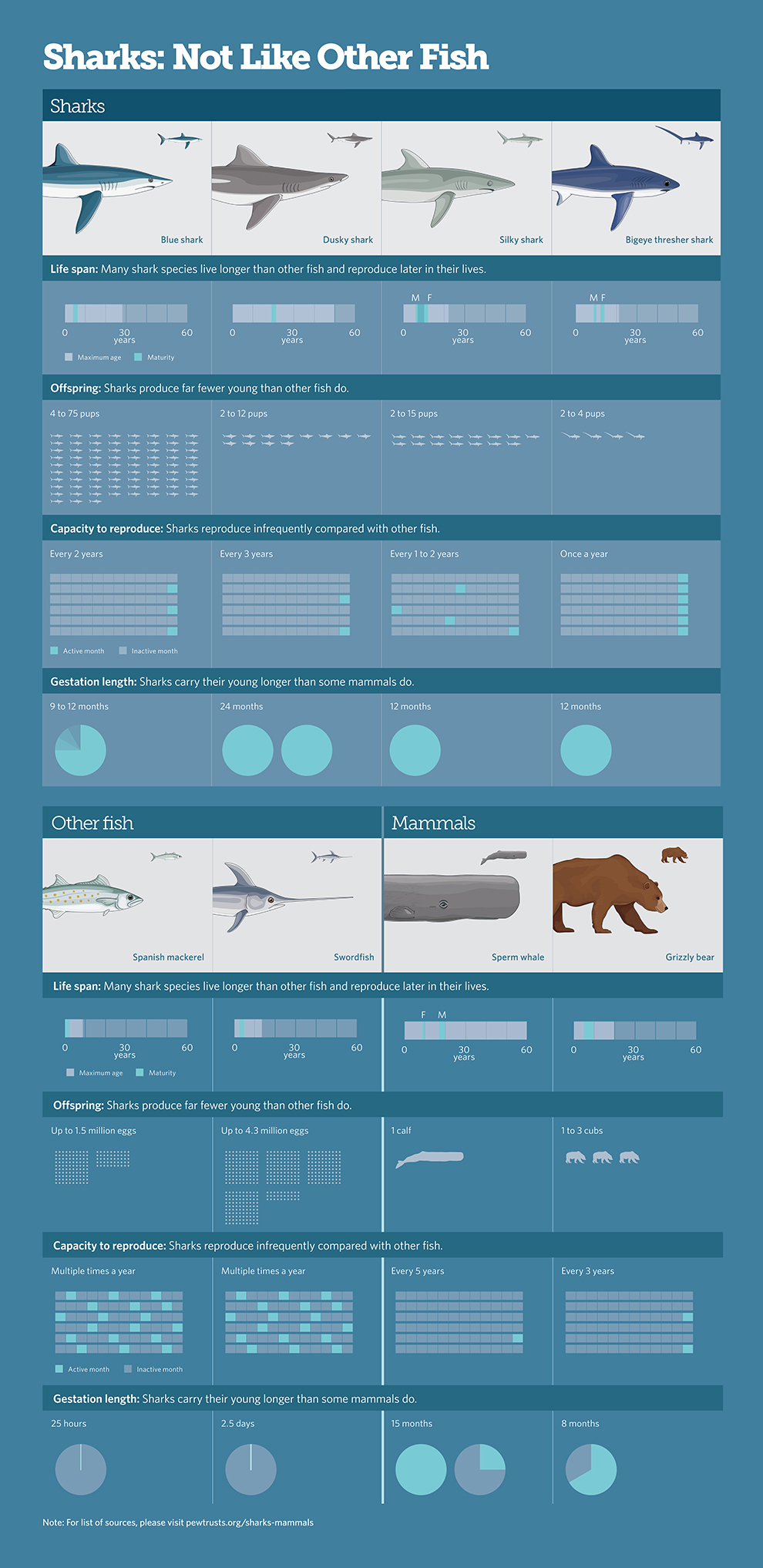Considering Shark Biology in Management
The population growth of any species depends on its life-history characteristics. With many of the world’s shark populations declining, it is important to examine how these characteristics differ from other fish to identify the most effective management approaches.
In most cases, bony fish achieve sexual maturity at an early age, reproduce often, and have many offspring (Poisson and Fauvel 2009). In comparison, sharks grow slowly, mature later in life, and have few offspring (Simpfendorfer et al. 2008). For example, a female shark that produced 10 pups every two years for 20 years would add only about 100 individuals to the population. In contrast, a female swordfish could produce millions of offspring in her lifetime, and thousands could survive (Poisson and Fauvel 2009).
The life histories of many sharks are actually more similar to those of large mammals than to other fish. For example, the age at sexual maturity and gestation period of many shark species approximate that of large mammals.
Owing to their similar life histories, management approaches used for large mammals that have undergone steep population declines could hold promise for sharks. For example, trade in sperm whale and brown bear products are strictly regulated under Appendices I and II of the Convention on International Trade in Endangered Species of Wild Fauna and Flora (CITES). Additionally, the global moratorium on commercial whaling and the listing of sperm whales on Appendices I and II of the Convention on Migratory Species assisted in this species’ recovery.
Because of the life-history characteristics of sharks, conventional fisheries management approaches, such as reaching maximum sustainable yield, may not be sufficient to rebuild depleted shark populations. Some of the more stringent approaches used to reverse declines in large mammals, however, may be appropriate for sharks, including prohibitions on the retention of the most vulnerable species and CITES Appendixes I and II listings that regulate international trade.
Download a full-width version of this infographic (PDF)

References
Poisson, F., and C. Fauvel. 2009. “Reproductive Dynamics of Swordfish (Xiphias gladius) in the Southwestern Indian Ocean (Reunion Island). Part 2: Fecundity and Spawning Pattern.” Aquatic Living Resources 22: 59–68.
Simpfendorfer, C., E. Cortés, M. Heupel, E. Brooks, E. Babcock, J. Baum, R. McAuley, S. Dudley, J.D. Stevens, S. Fordham, and A. Soldo. 2008. “An Integrated Approach to Determining the Risk of Over-Exploitation for Data-Poor Pelagic Atlantic Sharks.” SCRS/140. International Commission for the Conservation of Atlantic Tunas, Madrid.
Additional infographic sources
Atlantic States Marine Fisheries Commission. 2006. “Species Profile: Spanish Mackerel South Atlantic Species Thrives Under JointManagement Efforts.” Fisheries Focus 15: 4–5.
Bonfil, R., R. Mena, and D. de Anda. 1993. “Biological Parameters of Commercially Exploited Silky Sharks, Carcharhinus falciformis, From the Campeche Bank, Mexico.” In Conservation Biology of Elasmobranchs. NOAA Technical Report NMFS 115, 73–86. National Marine Fisheries Service, Silver Spring, MD, http://spo.nwr.noaa.gov/tr115.
Branstetter, S. 1987. “Age, Growth and Reproductive Biology of the Silky Shark, Carcharhinus falciformis, and the Scalloped Hammerhead, Sphyrna lewini, From the Northwestern Gulf of Mexico.” Environmental Biology of Fishes 19 (3): 161–173, http://link.springer.com/article/10.1007/BF00005346#page-2.
Castro, J.A., and J. Mejuto. 1995. “Reproductive Parameter of Blue Shark, Prionace glauca, and Other Sharks in the Gulf of Guinea.” Marine and Freshwater Research 46: 967–973.
Chen, C., K. Liu, and Y. Chang. 1997. “Reproductive Biology of the Bigeye Thresher Shark, Alopias superciliosus (Lowe, 1839) (Chondrichthyes: Alopiidae), in the Northwestern Pacific.” Ichthyological Research 44 (3): 227–235.
Cooksey, C.L. 1996. Reproductive Biology of Spanish Mackerel, Scromberomorus maculatus, in the Lower Chesapeake Bay. Master’s thesis. Virginia Institute of Marine Science.
Cortés, E., E. Brooks, P. Apostolaki, and C.A. Brown. 2006. “Stock Assessment of the Dusky Shark in the U.S. Atlantic and Gulf of Mexico. National Marine Fisheries Service, Silver Spring, MD.
Last, P.R., and J.D. Stevens. 1994. Sharks and Rays of Australia. Hobart, Australia: CSIRO Division of Fisheries.
Liu, K., P. Chiang, and C. Chen. 1998. “Age and Growth Estimates of the Bigeye Thresher Shark, Alopias superciliosus, in Northeastern Taiwan Waters.” Fishery Bulletin 96: 482–491.
McLellan, B.N., C. Servheen, and D. Huber. 2008. “Ursus arctos.” IUCN Red List of Threatened Species. Version 2014.3. Accessed May 20, 2015. http://www.iucnredlist.org/details/41688/0.
Moreno, J.A., and J. Morón. 1992. “Reproductive Biology of the Bigeye Thresher Shark, Alopias superciliosus (Lowe, 1839).” Australian Journal of Marine and Freshwater Research 43: 77–86.
Nakano, H. 1994. “Age, Reproduction and Migration of Blue Shark in the North Pacific Ocean.” Bulletin of National Research Institute of Far Seas Fisheries 31: 141–256.
National Oceanic and Atmospheric Administration Fisheries Service. 2006. “Draft Recovery Plan for the Sperm Whale (Physeter microcephalus).” Office of Protected Resources, Silver Spring, MD.
Palko, B.J., G.L. Beardsley, and W.J. Richards. 1981. “Synopsis of the Biology of the Swordfish, Xiphias gladius (Linnaeus, 1758).” NOAA Technical Report NMFS Circular 441. National Marine Fisheries Service, Silver Spring, MD.
Pratt, H.L. Jr. 1979. “Reproduction in the Blue Shark, Prionace glauca.” Fisheries Bulletin 77: 445–470.
Skomal, G.B., and L.J. Natanson. 2002. “Age and Growth of the Blue Shark, Prionace glauca, in the North Atlantic Ocean.” Collective Volume of Scientific Papers ICCAT 54: 1212–1230.
U.S. Fish and Wildlife Service. 2007. “Grizzly Bear (Ursus arctos horribilis).” Endangered Species Program, Arlington, VA.
Valeiras, X., J. Mejuto, and M. Ruiz. “Age and Growth of Swordfish (Xiphias gladius) in the North Pacific.” Paper presented at the Fourth Regular Session of the Western and Central Pacific Fisheries Commission’s Scientific Committee, Port Moresby, Papua New Guinea, Aug. 11-22, 2008.



